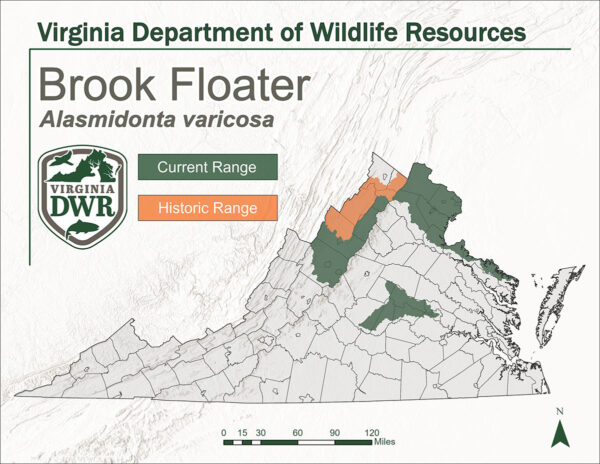Brook Floater encountered during a survey
Brook Floater with Hallprint Tag
Tagged Brook Floater ready for release
Fact File
Scientific Name: Alasmidonta varicosa
Classification: Freshwater Mussel, Family Unionidae
Conservation Status:
- State Endangered in Virginia
- Species of Greatest Conservation Need-Tier 1a on the Virginia Wildlife Action Plan
Size: 70 mm
Life Span: 14 years
Identifying Characteristics
- Shell is thin, elongated, and slightly inflated
- The anterior end is curved, and the posterior end is curved to slightly squarish
- The ventral margin is slightly concave
- Numerous ridges are present in the dorsal-posterior region
- The outer covering of the shell (periostracum) can be yellow or green, darkening to black with age
- Rays are dark green and prominent in juveniles, but may be obscured on the darker shells of adults
- The inner portion of the shell (nacre) is bluish-white, often containing shades of pink or purple
Habitat
The Brook Floater inhabits small streams to large rivers of a low to moderate gradient. It is typically observed in riffles and runs, with a substrate composition of coarse sand and gravel.
Distribution
The Brook Floater occurs in the James and Potomac River basins in Virginia. However, it has experienced a dramatic reduction in its range within the state.

Life History
Freshwater mussels have a very unique life cycle. Parasitic larvae, called glochidia, develop in the gills of the female mussel. Once mature, the glochidia are expelled from the gills of the mussel and must attach to the gills of a suitable host fish, where they complete their transformation into a juvenile mussel. They then detach from the fish and begin their free-living existence on the river bottom.
Some freshwater mussels are host-specialists, meaning that metamorphosis can only occur on a limited number of closely related fish species, while others are host-generalists, with the ability to complete their life cycle using many different species. The Brook Floater has a variety of suitable hosts, although host fish trials have determined Brook Trout (Salvelinus fontinalis), Longnose Dace (Rhinichthys cataractae), and Slimy Sculpin (Cottus cognatus) to be the most successful.
Conservation
The Brook Floater is one of the rarest mussels native to the Atlantic Slope in Virginia. Efforts by the Virginia Fisheries and Aquatic Wildlife Center (VFAWC), Virginia Tech’s Freshwater Mollusk Conservation Center (FMCC), and Virginia Tech’s Conservation Management Institute (CMI) to restore this species are currently underway. As of 2024, over 4,000 hatchery-propagated Brook Floater have been released at multiple sites throughout the Potomac River basin. DWR biologists and partners routinely visit these sites to track the growth and survival of the released mussels, and to guide future restoration efforts.
First Release in the James River
In 2024, more than 400 Brook Floater were released into the mainstem James River. Prior to this release, the Brook Floater had not been observed in the James in 27 years!
Special Considerations
Freshwater mussels are extremely imperiled organisms. DWR regulates the take and possession of freshwater mussels occurring within the state. It is unlawful to take mussels from any inland waters in the Commonwealth except as provided for in §§ 29.1-418 and 29.1-568 of the Code of Virginia. Additionally, the Brook Floater is listed as an endangered species under Virginia law. It is a violation of state law to harass, harm, or take the Brook Floater in Virginia.
For more information, see Virginia’s Endangered Species Act.
Last updated: July 12, 2025
The Virginia Department of Wildlife Resources Species Profile Database serves as a repository of information for Virginia’s fish and wildlife species. The database is managed and curated by the Wildlife Information and Environmental Services (WIES) program. Species profile data, distribution information, and photography is generated by the Virginia Department of Wildlife Resources, State and Federal agencies, Collection Permittees, and other trusted partners. This product is not suitable for legal, engineering, or surveying use. The Virginia Department of Wildlife Resources does not accept responsibility for any missing data, inaccuracies, or other errors which may exist. In accordance with the terms of service for this product, you agree to this disclaimer.

